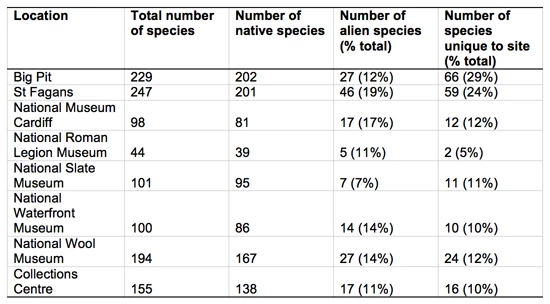The nature of museums: Vascular plants at Amgueddfa Cymru
A few species of conservation interest were found. Groenlandia densa (Opposite-leaved pondweed) is a declining aquatic plant and the ornamental ponds at St Fagans, where it is abundant, is of its very few remaining Welsh sites. It is classed as Vulnerable on the Red List for Wales (Dines 2008).
A small quantity of Rorippa islandica (Northern Yellowcress) was found on damp waste ground at the Collections Centre in Nantgarw. This species has been spreading rapidly in south Wales during the last decade.
subsp. majus (Fern grass) is a rare grass that has been persistent, despite herbicide treatment, on the cobbles at National Museum Cardiff since at least 1997.
Studies of vascular plant species across Amgueddfa Cymru's eight locations reveal the importance of protecting fragile ecosystems.
Recent legislation, the so-called "Biodiversity Duty" (Section 40 of the Natural Environment and Rural Communities Act 2006), aims to raise the profile and visibility of biodiversity and states that "Every public authority must, in exercising its functions, have regard, so far as is consistent with the proper exercise of those functions, to the purpose of conserving biodiversity".
In response, we are carrying out biodiversity surveys at the eight Amgueddfa Cymru locations. The aim is to find out which species are present so that the biodiversity of the sites can be maintained and enhanced. In this article we're looking at the vascular plants — flowers, ferns, trees and so forth.
The method
The surveys were carried out in 2008 and 2009. All vascular plant species, except deliberately planted or cultivated species, were recorded with notes on their frequency and habitats.
Results
In all, 456 species were recorded; 364 (80%) were natives or aliens known to be here since before the year 1500, and 92 were alien species introduced since 1500. There are about 1,400 plant species in Wales that are native or known to have been here since 1500, excluding critical genera such as Hieracium, Taraxacum and Rubus (T. Dines (2008) A vascular plant Red Data List for Wales. Plantlife International, London). Amgueddfa Cymru's eight locations have 26% of the Welsh flora.
The number of species present at each site varied, partly depending on the size of the site and partly on the habitats (Table 1). The richest sites were St Fagans, where there are extensive gardens and woodland, and Big Pit, which has coal tips and moorland as well as buildings and grassland. The sites with lowest diversities were the National Roman Legion Museum at Caerleon, where land is essentially restricted to a garden, and National Museum Cardiff and the National Waterfront Museum in Swansea, which are mostly urban grasslands.
The numbers of alien species also varied, the highest proportion being at St Fagans, where many aliens had naturalised from gardens, and National Museum Cardiff in Cardiff city centre. The National Slate Museum in Llanberis had significantly fewer aliens. The only serious alien infestations were of Himalayan Balsam (Impatiens glandulifera) at the National Wool Museum in Dre-fach Felindre and St Fagans, and Japanese Knotweed (Fallopia japonica) at St Fagans.
200 (45%) of the species occur only at one or other of the sites (Figure 1), and protecting these is clearly important for maintaining Amgueddfa Cymru's overall biodiversity. The high number of unique species at Big Pit is largely due to the occurrence of moorland and coal tips with a different flora to the other, largely lowland, sites. 16 species were found at all eight sites.
Other plants of interest included Monks-hood (Aconitum napellus), Sea Stork's-bill (Erodium maritimum), Glabrous whitlowgrass (Erophila glabrescens), Ivy Broomrape (Orobanche hederae) and Southern Polypody (Polypodium cambricum). Potamogeton trichoides, recorded in several of the St Fagans ponds in 1992, was not refound. Other than these, most of the plants found are relatively common and widespread in Wales.
The overall number of plant species was quite surprising, even if it largely consisted of relatively common species. The diversity at Big Pit, St Fagans and the National Wool Museum means that those museum sites can be used for education. The more interesting species can now be monitored and looked after.
Table 1. Summary of species data for Amgueddfa Cymru locations.
Figure 1. Frequencies of the number of locations in which each species has been recorded.




